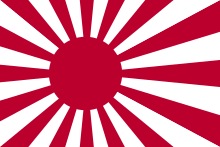National flag
A national flag is a flag that represents and symbolizes a given nation. It is flown by the government of that nation, but usually can also be flown by its citizens. A national flag is typically designed with specific meanings for its colours and symbols, which may also be used separately from the flag as a symbol of the nation. The design of a national flag is sometimes altered after the occurrence of important historical events. The burning or destruction of a national flag is a greatly symbolic act.
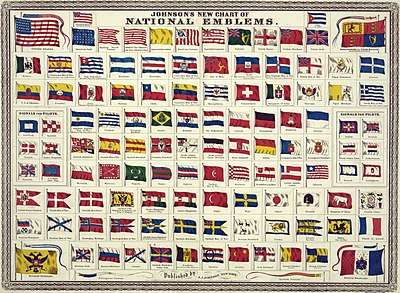
History
Historically, flags originate as military standards, used as field signs. The practice of flying flags indicating the country of origin outside of the context of warfare became common with the maritime flag, introduced during the age of sail, in the early 17th century. The origins of the Union Jack flag date back to 1603, when James VI of Scotland inherited the English and Irish thrones (as James I), thereby uniting the crowns of England, Scotland and Ireland in a personal union (which remained separate states). On 12 April 1606, a new flag to represent this regal union between England and Scotland was specified in a royal decree, according to which the flag of England (a red cross on a white background, known as St George's Cross), and the flag of Scotland (a white saltire on a blue background, known as the Saltire or St Andrew's Cross), would be joined together, forming the flag of Great Britain and first Union Flag.
With the emergence of nationalist sentiment from the late 18th century national flags began to be displayed in civilian contexts as well.[1] Notable early examples include the US flag, which was first adopted as a naval ensign in 1777 but began to be displayed as a generic symbol of the United States after the American Revolution, and the French Tricolore, which became a symbol of the Republic in the 1790s.
Most countries of Europe adopted a national flag in the course of the 19th and early 20th centuries, often based on older (medieval) war flags. The specifications of the flag of Denmark were codified in 1748, based on a 14th-century design.[2] The flag of Switzerland was introduced in 1889, also based on medieval war flags. The Netherlands introduced two national flags in 1813 (either an orange-white-blue or a red-white-blue tricolour; the final decision in favour of red was made in 1937).
The Ottoman flag (now the flag of Turkey) was adopted in 1844. Other non-European powers followed the trend in the late 19th century, the flag of Japan being introduced in 1870, that of Qing China in 1890. Also in the 19th century, most countries of South America introduced a flag as they became independent (Peru in 1820, Bolivia in 1851, Colombia in 1860, Brazil in 1822, etc.)
Process of adoption
The national flag is often, but not always, mentioned or described in a country's constitution, but its detailed description may be delegated to a flag law passed by the legislative, or even secondary legislation or in monarchies a decree.
Thus, the national flag is mentioned briefly in the Basic Law for the Federal Republic of Germany of 1949 "the federal flag is black-red-gold" (art. 22.2 Die Bundesflagge ist schwarz-rot-gold), but its proportions were regulated in a document passed by the government in the following year. The Flag of the United States is not defined in the constitution but rather in a separate Flag Resolution passed in 1777.
Minor design changes of national flags are often passed on a legislative or executive level, while substantial changes have constitutional character. The design of the flag of Serbia omitting the communist star of the flag of Yugoslavia was a decision made in the 1992 Serbian constitutional referendum, but the adoption of a coat of arms within the flag was based on a government "recommendation" in 2003, adopted legislatively in 2009 and again subject to a minor design change in 2010. The Flag of the United States underwent numerous changes because the number of stars represents the number of states, proactively defined in a Flag Act of 1818 to the effect that "on the admission of every new state into the Union, one star be added to the union of the flag"; it was changed for the last time in 1960 with the accession of Hawaii.
A change in national flag is often due to a change of regime, especially following a civil war or revolution. In such cases, the military origins of the national flag and its connection to political ideology (form of government, monarchy vs. republic vs. theocracy, etc.) remains visible. In such cases national flags acquire the status of a political symbol.
The flag of Germany, for instance, was a tricolour of black-white-red under the German Empire, inherited from the North German Confederation (1866). The Weimar Republic that followed adopted a black-red-gold tricolour. Nazi Germany went back to black-white-red in 1933, and black-red-gold was reinstituted by the two successor states, West Germany and East Germany, with East Germany's flag being defaced with Communist symbols, following World War II. Similarly the flag of Libya introduced with the creation of the Kingdom of Libya in 1951 was abandoned in 1969 with the coup d'état led by Muammar Gaddafi. It was used again by National Transitional Council and by anti-Gaddafi forces during the Libyan Civil War in 2011 and officially adopted by the Libyan interim Constitutional Declaration.
Usage
There are three distinct types of national flag for use on land, and three for use at sea, though many countries use identical designs for several (and sometimes all) of these types of flag.
On land
On land, there is a distinction between civil flags (FIAV symbol ![]()
![]()
![]()
In practice, many countries (such as the United States and the United Kingdom) have identical flags for these three purposes; national flag is sometimes used as a vexillological term to refer to such a three-purpose flag (![]()
Very few countries use a war flag that differs from the state flag. The People's Republic of China, the Republic of China (Taiwan), and Japan are notable examples of this. Swallow-tailed flags are used as war flags and naval ensigns in Nordic countries and charged versions as presidential or royal standards. The Philippines does not have a distinctive war flag in this usual sense, but the flag of the Philippines is legally unique in that it is flown with the red stripe on top when the country is in a state of war, rather than the conventional blue.
At sea
The flag that indicates nationality on a ship is called an ensign. As with the national flags, there are three varieties: the civil ensign (![]()
![]()
![]()
In some countries, such as the United States and Canada (except for the Royal Canadian Navy's Ensign), the national ensign is identical to the national flag, while in others, such as the United Kingdom and Japan, there are specific ensigns for maritime use. Most countries do not have a separate state ensign, although the United Kingdom is a rare exception, in having a red ensign for civil use, a white ensign as its naval ensign, and a blue ensign for government non-military vessels.
Protocol

There is a great deal of protocol involved in the proper display of national flags. A general rule is that the national flag should be flown in the position of honour, and not in an inferior position to any other flag (although some countries make an exception for royal standards). The following rules are typical of the conventions when flags are flown on land:
- When a national flag is displayed together with any other flags, it must be hoisted first and lowered last.
- When a national flag is displayed together with the national flags of other countries, all the flags should be of approximately equal size and must be flown at an equal height, although the national flag of the host country should be flown in the position of honour (in the centre of an odd number of flagpoles or at the far right — left from an observer's point of view — of an even number of flagpoles).
- When a national flag is displayed together with flags other than national flags, it should be flown on a separate flagpole, either higher or in the position of honour.
- When a national flag is displayed together with any other flags on the same flagpole, it must be at the top, though separate flagpoles are preferable.
- When a national flag is displayed together with any other flag on crossed flagpoles, the national flag must be on the observer's left and its flagpole must be in front of the flagpole of the other flag.
- When a national flag is displayed together with another flag or flags in procession, the national flag must be on the marching right. If there is a row of flags, it should be in the position of honour.
- When a national flag, with some exceptions, is flown upside down it indicates distress. This however is merely tradition. It is not a recognised distress signal according to the International regulations for preventing collisions at sea. Further, a nation's flag is commonly flown inverted as a sign of protest or contempt against the country concerned. As of now, only the flag of the Philippines recognises the distress symbolism of the reverse flag.
Hanging a flag vertically
Most flags are hung vertically by rotating the flag pole. However, some countries have specific protocols for this purpose or even have special flags for vertical hanging; usually rotating some elements of the flag — such as the coat of arms — so that they are seen in an upright position.[3]
Examples of countries that have special protocol for vertical hanging are: Canada, Czech Republic, Greece, Israel, the Philippines, Saudi Arabia, South Africa, and the United States (reverse always showing); and the United Kingdom (obverse always showing).
Examples of countries that have special designs for vertical hanging are: Austria, Germany, Hungary, Mexico, Montenegro, Poland, and Slovakia (coat of arms must be rotated to normal position); Cambodia (coat of arms must be rotated and blue strips are narrowed); Dominica (coat of arms must be rotated and reverse always showing); Liechtenstein (crown must be rotated).
 Vertical variation of the flag of Slovakia.
Vertical variation of the flag of Slovakia.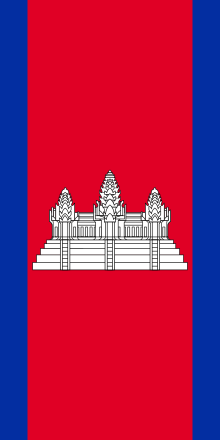 Vertical variation of the flag of Cambodia.
Vertical variation of the flag of Cambodia. Vertical variation of the flag of Dominica.
Vertical variation of the flag of Dominica. Vertical variation of the flag of Liechtenstein.
Vertical variation of the flag of Liechtenstein.
Design

The art and practice of designing flags is known as vexillography. The design of national flags has seen a number of customs become apparent.
All national flags are rectangular, except for the flag of Nepal. The ratios of height to width vary among national flags, but none is taller than it is wide, again except for the flag of Nepal. The flags of Switzerland and the Vatican City are the only national flags which are exact squares.
The obverse and reverse of all national flags are either identical or mirrored, except for the flag of Paraguay and the partially recognized Sahrawi Arab Democratic Republic. See Flags whose reverse differs from the obverse for a list of exceptions including non-national flags.
As of 2011 all national flags consist of at least two different colours. In many cases, the different colours are presented in either horizontal or vertical bands. It is particularly common for colours to be presented in bands of three.
It is common for many flags to feature national symbols, such as coats of arms. National patterns are present in some flags. Variations in design within a national flag can be common in the flag's upper left quarter, or canton.
Colours
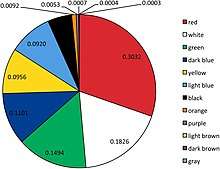
The most popular colours in national flags are red, white, green, dark blue, yellow, light blue, and black.[4] The only national flag not to include the colors red, white, or blue is Jamaica[5]. The occurrence of each colour in all the flags is listed in detail in the table below.[4] The table shows that the colours light brown, dark brown and grey only occur in very small quantities. In fact, they only occur in the symbols on flags, such as in the Spanish flag.
| Colour | Area (%) | Count of flags |
|---|---|---|
| red | 30.32 | 155 |
| white | 18.26 | 144 |
| green | 14.94 | 97 |
| dark blue | 11.01 | 68 |
| yellow | 9.56 | 102 |
| light blue | 9.20 | 44 |
| black | 5.12 | 69 |
| orange | 0.92 | 12 |
| purple | 0.53 | 6 |
| light brown | 0.07 | 12 |
| dark brown | 0.04 | 10 |
| grey | 0.03 | 7 |
Similarities
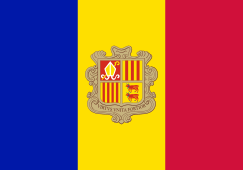
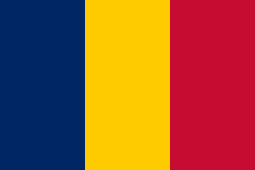

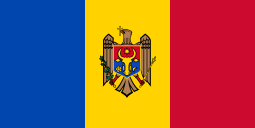
Although the national flag is meant to be a unique symbol for a country, many pairs of countries have highly similar flags. Examples include the flags of Monaco and Indonesia, which differ only slightly in proportion and the tint of red; the flags of the Netherlands and Luxembourg, which differ in proportion as well as in the tint of blue used; and the flags of Romania and Chad, which differ only in the tint of blue.
The flags of Ireland and Côte d'Ivoire and the flags of Mali and Guinea are (aside from shade or ratio differences) vertically mirrored versions from each other. This means that the reverse of one flag matches the obverse of the other. Other than horizontal mirrored flags (like Poland and Indonesia) the direction in which these flags fly are crucial to identify them.
There are three colour combinations that are used on several flags in certain regions. Blue, white, and red is a common combination in Slavic countries such as the Czech Republic, Slovakia, Russia, Serbia, Slovenia, and Croatia as well as among Western nations including Australia, France, Iceland, Norway, New Zealand, the United Kingdom, the Netherlands and the United States of America. Many African nations use the Pan-African colours of red, yellow, and green, including Ghana, Cameroon, Mali and Senegal. Flags containing red, white, and black (a subset of the Pan-Arab colours) can be found particularly among the Arab nations such as Egypt, Iraq, Syria and Yemen.
While some similarities are coincidental, others are rooted in shared histories. For example, the flags of Colombia, of Ecuador, and of Venezuela all use variants of the flag of Gran Colombia, the country they composed upon their independence from Spain, created by the Venezuelan independence hero Francisco de Miranda; and the flags of Kuwait, of Jordan, and of Palestine are all highly similar variants of the flag of the Arab revolt of 1916–1918. The flags of Romania and Moldova are virtually the same, because of the common history and heritage. Moldova adopted the Romanian flag during the declaration of independence from the USSR in 1991 (and was used in various demonstrations and revolts by the population) and later the Moldovan coat of arms (which is part of the Romanian coat of arms) was placed in the centre of the flag. All Nordic countries, with the exception of Greenland, use the Nordic Cross design (Iceland, Denmark, Norway, Sweden, Finland, in addition to the autonomous regions of the Faroe Islands and Åland), a horizontal cross shifted to the left on a single-coloured background. The United States and United Kingdom both have red, white, and blue. This similarity is due to the fact that the first 13 states of the U.S. were formerly colonies of the United Kingdom. Also, Australia and New Zealand have very similar flags, which stems from their joint British heritage. Both of these flags feature the Union Jack in one corner, both have royal blue background, and both have the Southern Cross as a prominent feature. The only differences between these flags is that the Australian flag has the Commonwealth Star below the canton, and that on the New Zealand flag, just four stars in the Southern Cross are presented, and they are five-pointed red stars with white borders. On the other hand, all five stars of the Southern Cross are presented on the Australian flag, and they are white with seven points, except for the additional smaller fifth star in the Southern Cross which has only five points on this flag. Some similarities to the United States flag with the red and white stripes are noted as well such as the flag of Malaysia and the flag of Liberia, the latter of which was an American resettlement colony.
Many other similarities may be found among current national flags, particularly if inversions of colour schemes are considered, e.g., compare the flag of Senegal to that of Cameroon and Indonesia to Poland and Monaco. Also the Flag of Italy and the Flag of Hungary uses the same colours, although the order and direction differ (the Italian flag is vertical green-white-red and the Hungarian flag is horizontal red-white-green).
See also
- Lists of flags
- Lists of flags
- Gallery of sovereign state flags
- Gallery of flags of dependent territories
- Timeline of national flags
- List of flags by colour combination
- Other
References
- "Flags" in German, French and Italian in the online Historical Dictionary of Switzerland.
- Dannebrog (in Danish). Den Store Danske. 2014. Archived from the original on 2014-07-14. Retrieved 2014-06-13.
- Nelson, Phil (2005-12-31), Hanging Flags Vertically, Flags of the World, archived from the original on 2010-12-17, retrieved 2011-02-20.
- Bartneck, Christoph; Adrian Clark (2014). "Semi-Automatic Color Analysis For Brand Logos". Color Research and Application. 40: 72–84. doi:10.1002/col.21853.
- "What Do the Colors and Symbols of the Flag of Jamaica Mean?". World Atlas. Retrieved 17 July 2020.
External links
| Wikimedia Commons has media related to National flags of countries. |
- Flags of the World, a massive online vexillological database on national and many other kinds of flags
- The World All Countries Flags, a website about national symbols
- World Flag Database reverse search for ID by colour and layout
- for flag construction diagrams, flags of subnational entities, historical flags and country subdivisions
- Extensive list of similar flags from around the world

.svg.png)

